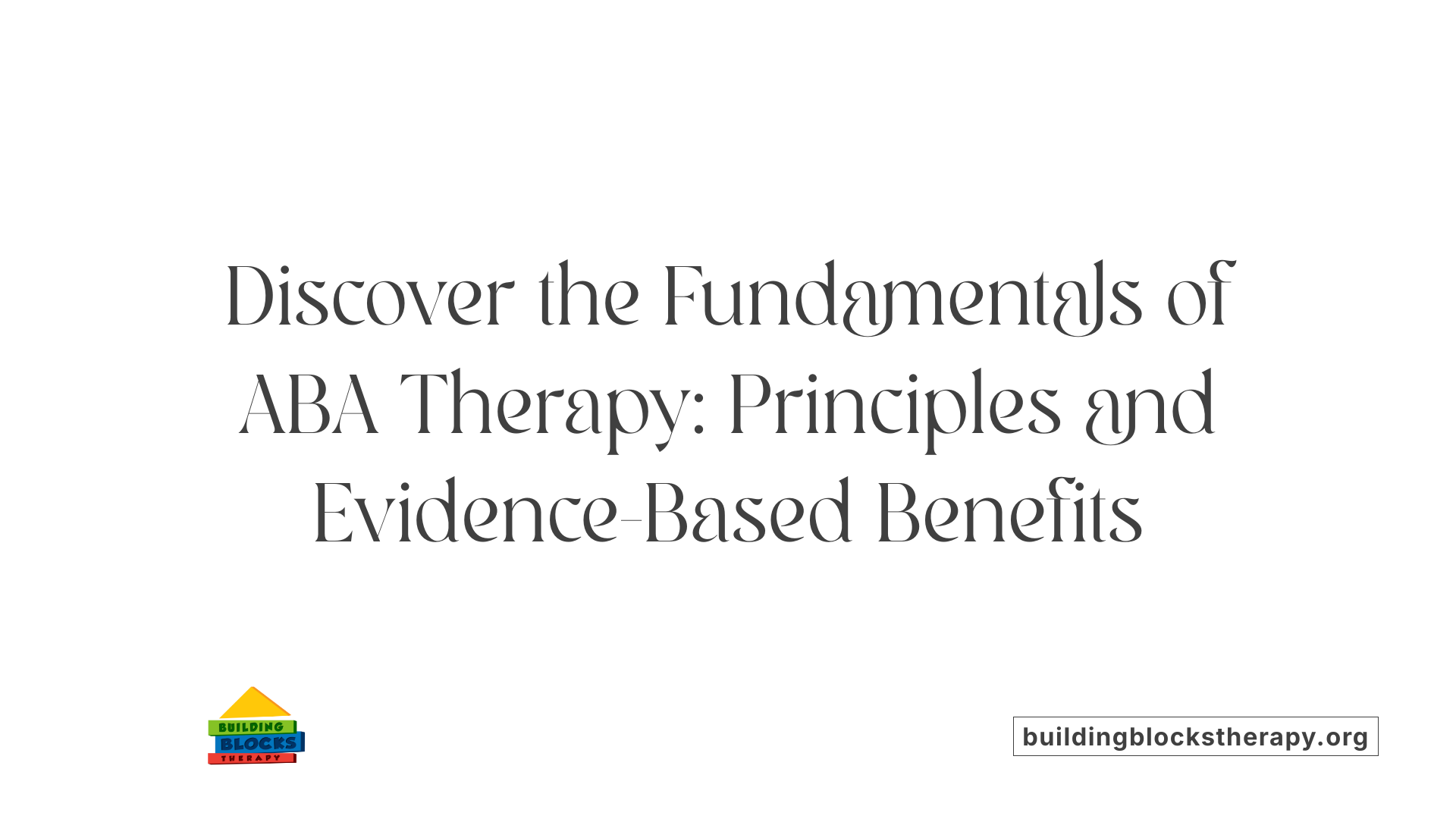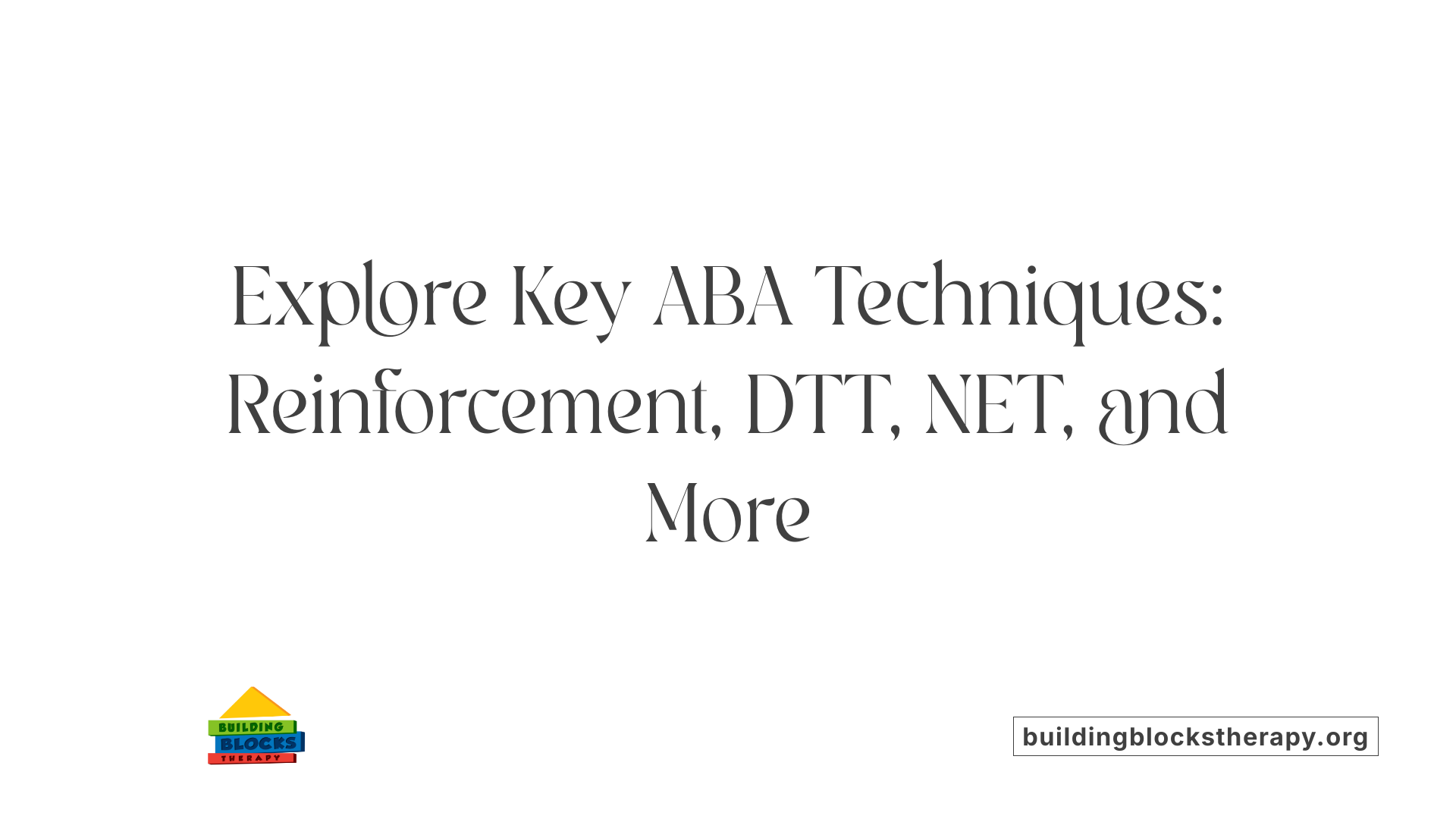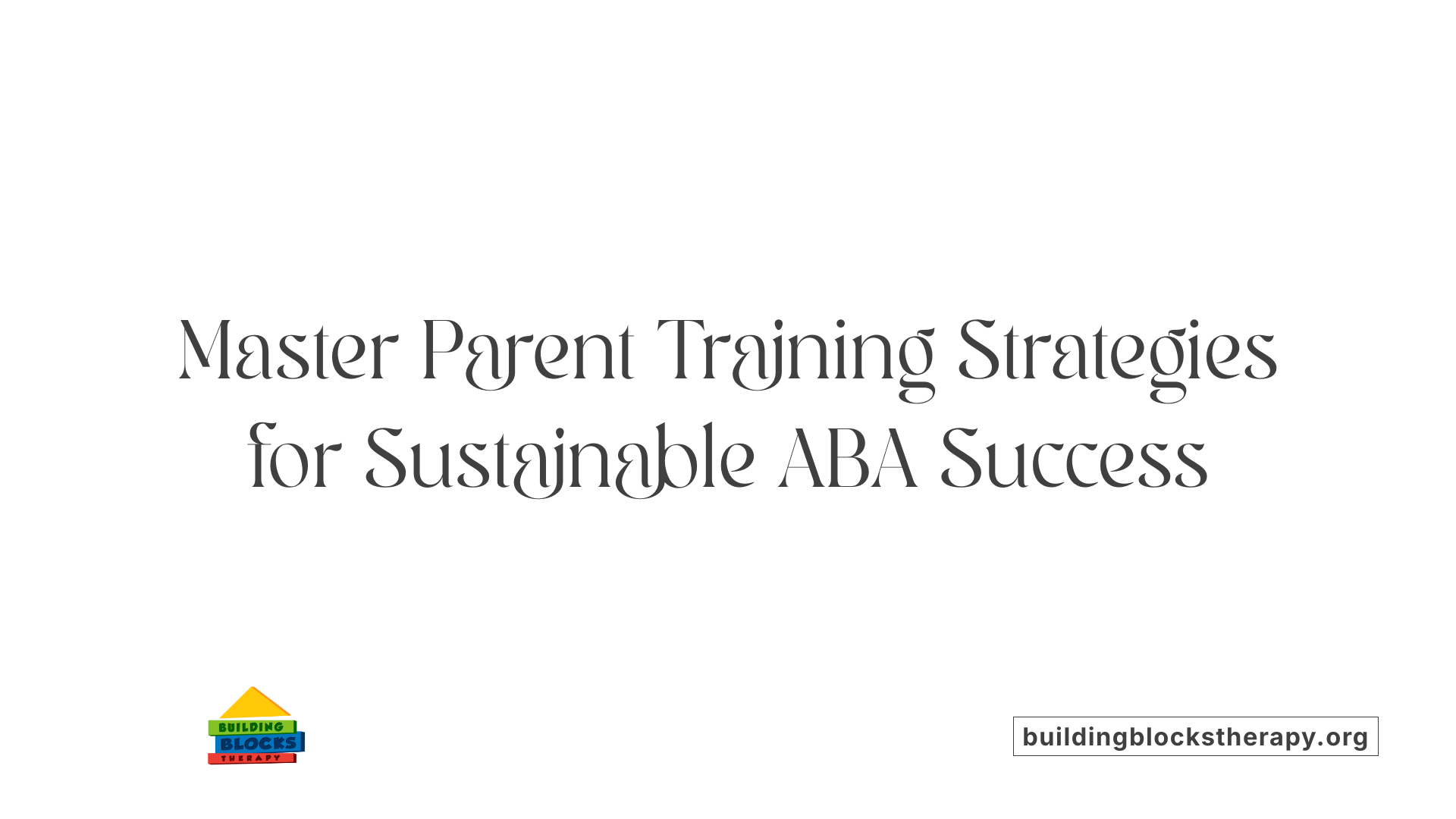Parent Training in Autism Intervention
Empowering Families: The Critical Role of Parent Training in ABA for Autism

Understanding ABA Therapy and Its Impact
Applied Behavior Analysis (ABA) therapy is a scientifically validated approach designed to improve behavioral and developmental outcomes for individuals with autism spectrum disorder (ASD). Fundamental to ABA's success is its individualized design and emphasis on increasing meaningful skills while reducing problematic behaviors. However, a growing body of evidence highlights that parent training within ABA intervention is pivotal in ensuring these benefits extend beyond clinical settings.
What Is Applied Behavior Analysis (ABA) Therapy?

Definition and principles of ABA
Applied Behavior Analysis (ABA) is a therapy grounded in the science of learning and behavior. It explores how behaviors work, how the environment affects them, and the processes through which learning happens. ABA therapy aims to increase helpful behaviors while decreasing harmful or problematic ones, supporting individuals in gaining greater independence.
Individualized program design
ABA programs are carefully customized to meet the specific needs of each individual, especially those with autism spectrum disorder (ASD). A qualified behavioral analyst, called a BCBA, conducts thorough assessments and designs programs with clear, measurable goals. These programs cover diverse skills such as communication, social interactions, self-care, play, motor abilities, and academics.
Role of positive reinforcement and other techniques
A central technique in ABA is positive reinforcement, where desired behaviors are rewarded to encourage their repetition. Other methods include analyzing antecedents and consequences to understand behavior patterns, discrete trial training (DTT), and communication systems like the Picture Exchange Communication System (PECS). These approaches work together to effectively teach new skills and reduce challenging behaviors.
Evidence supporting ABA effectiveness
Strong scientific evidence backs the effectiveness of ABA therapy. More than 20 studies have shown improvements in intellectual functioning, language, social skills, and daily living abilities when ABA is provided in intensive, long-term programs. This evidence highlights ABA as a reliable intervention for enhancing the quality of life for individuals with autism.
Who Provides ABA Therapy and How Are Programs Structured?

Credentials and Roles of BCBAs and Therapists
ABA therapy is primarily delivered by professionals known as Board Certified Behavior Analysts (BCBAs). These specialists are responsible for designing and overseeing individualized ABA programs tailored to each person's unique needs through detailed assessments and setting measurable goals. Registered Behavior Technicians (RBTs) and other trained therapists implement the therapy sessions following BCBA guidance.
Settings Where ABA Is Delivered
ABA services are provided in various settings, including specialized clinics, schools, private practices, and community agencies. The availability and insurance coverage for these services can vary based on location.
Supervision and Collaboration With Families
A vital aspect of ABA therapy is collaboration with families. BCBAs involve parents, caregivers, and family members through training, equipping them with the skills and knowledge to support the child's development outside of therapy sessions. This partnership ensures consistent implementation of strategies, improving progress and generalizing skills across environments.
Program Customization and Ongoing Assessment
Individual ABA programs are customized to address diverse skill areas such as communication, social skills, self-care, play, motor skills, and academics. BCBAs continually assess progress and adjust programs to meet evolving needs, ensuring the therapy remains effective and relevant.
| Provider Role | Responsibilities | Setting Examples |
|---|---|---|
| Board Certified Behavior Analyst (BCBA) | Designs and supervises ABA programs; sets goals | Clinics, schools, private practice, community agencies |
| Registered Behavior Technician (RBT) | Implements ABA therapy under BCBA supervision | Various therapeutic environments |
| Parents and Caregivers | Participate in training; reinforce skills at home | Home, community settings |
Techniques Utilized in ABA and Their Role in Behavior Change

What techniques are used in ABA therapy?
ABA therapy uses several effective techniques grounded in behavioral science to support learning and behavior change.
Positive reinforcement is a central technique where desired behaviors are encouraged by offering rewards or praise, increasing the likelihood the behavior will be repeated.
Discrete Trial Training (DTT) involves breaking down skills into small, structured tasks that are taught repetitively in a controlled environment to promote mastery.
Natural Environment Teaching (NET) takes learning into everyday settings, helping individuals apply skills during real-life activities, which enhances generalization.
Another important method is Antecedent-Behavior-Consequence (ABC) analysis, which examines what happens before and after a behavior to understand its function and guide effective intervention.
ABA programs are highly individualized, selecting and combining these techniques based on detailed assessments of each person's unique needs. This tailored approach targets skill development across communication, social interaction, self-care, and other areas while addressing problematic behaviors.
By applying these strategies thoughtfully, ABA therapy helps increase positive behaviors and decrease harmful ones, supporting greater independence and quality of life.
The Benefits of Parent Training in ABA Intervention

Empowerment and knowledge for parents
Parent training in ABA equips caregivers with a deep understanding of behavioral principles and intervention techniques. This knowledge empowers parents to actively participate in their child's therapy, improving communication with therapists and increasing confidence in managing behaviors.
Supporting skill generalization in everyday settings
Training enables parents to apply ABA strategies consistently across various environments, such as at home and in the community. By reinforcing newly acquired skills in daily routines, parents help their children generalize behaviors beyond formal therapy sessions.
Consistency and reinforcement of behavior strategies
Consistent application of behavior modification strategies by parents ensures that positive behaviors are encouraged, while problem behaviors are minimized effectively. This repetitive reinforcement contributes to stronger, longer-lasting behavioral improvements.
Improving child outcomes and reducing therapy hours
Studies show that active parental involvement through training leads to better retention of positive behaviors and increased independence in children with autism. This can reduce the amount of professional therapy required, making treatment more accessible and cost-effective.
Strengthening family relationships and reducing anxiety
Parent training fosters a supportive environment by promoting positive parent-child interactions. Additionally, it helps reduce parental stress and anxiety by providing a clearer understanding of therapy goals and practical tools, ultimately enhancing overall family well-being.
ABA therapy benefits individuals with autism by systematically teaching and reinforcing essential social, communication, and daily living skills, leading to increased independence and improved quality of life. Early and intensive ABA intervention can result in significant developmental gains, including better language skills, social interactions, and behavioral regulation, with programs tailored by qualified behavior analysts.
Implementing Effective Parent Training for Long-Term Success

What is the significance of parent training in ABA therapy?
Parent training is a crucial part of ABA therapy because it empowers parents and caregivers with the skills and knowledge to actively support their child's development. This training ensures that intervention strategies are consistently applied at home and other daily settings, which helps children generalize the skills they learn during therapy sessions.
Training parents to apply clinical strategies at home
Parents learn to implement specific ABA techniques, such as positive reinforcement and behavior replacement strategies, enabling them to encourage desirable behaviors and reduce challenging ones outside clinical environments. This active participation helps maintain and strengthen the child's progress over time.
Tailoring interventions to family dynamics
Parent training allows therapists to customize interventions based on each family's unique circumstances and the child's individual needs. Immediate feedback and adjustments during training sessions ensure that strategies fit well within the family routine, making them more practical and sustainable.
Maintaining and practicing learned skills
When parents are trained, they can regularly reinforce and practice skills with their child, supporting continued growth toward independence. This ongoing involvement is key to long-term success, preventing regression and enhancing the generalization of new behaviors across situations.
Reducing parental anxiety and building support networks
Training sessions not only teach skills but also provide emotional support, reducing parental stress and building a community of understanding caregivers. This network improves overall family well-being and resilience.
Enhancing the accessibility and cost-effectiveness of ABA
By equipping parents to implement strategies effectively, the need for extensive professional therapy sessions can be reduced. This makes ABA therapy more accessible to families and can lower costs while still supporting consistent progress.
In summary, effective parent training in ABA bridges therapy and daily life, ensuring that behavioral strategies are adapted, reinforced, and supported within the family environment for meaningful, lasting outcomes.
The Indispensable Role of Parents in ABA Autism Intervention
Parent training is not just a supplementary component but a cornerstone of effective ABA therapy for children with autism. By empowering parents with the tools and understanding necessary to support their child's development consistently across settings, ABA interventions achieve deeper and more sustained outcomes. This collaborative approach leverages the unique strengths of family dynamics, extends learning beyond clinical hours, and fosters greater independence for individuals with autism. Ultimately, investing in comprehensive parent training enriches both the therapeutic journey and the lives of families navigating autism together.
References
- Applied Behavior Analysis (ABA)
- Parent Training in Applied Behavior Analysis Treatment
- The Role of Parent Training in ABA Intervention
- Effective ABA Parent Training | Brady Behavior Analysis
- ABA Therapy Examples, Definition & Techniques
- Applied Behavior Analysis (ABA)
- Applied Behavior Analysis in Children and Youth with Autism ...
- Applied Behavior Analysis (ABA)
- The Top 10 Reasons Children With Autism Deserve ABA





